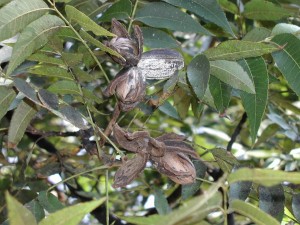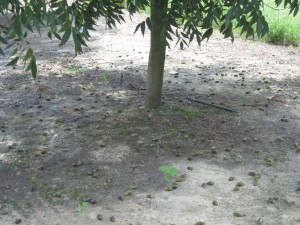We have about reached shell hardening on most of our pecans in Georgia at this point. There are a number of things that come along with shell hardening in the process of growing pecans:
Expect to see water stage fruit split soon
In the coming weeks you will likely see nuts dropping from the trees. While insects can cause this as well, mass nut shedding with no visible insect injury will likely be water split. Details from previous post below:
Water split is a major problem exhibited by thin-shelled pecan varieties (e.g., Schley, Caddo, Oconee, Sumner, Wichita, Frotscher, and Farley) and, to a lesser degree, by certain relatively thick-shelled cultivars (e.g., ‘Cape Fear’ and ‘Elliott’). The problem occurs when water pressure builds up rapidly inside the nut, causing the shell, seed coat, and sometimes the shuck to split about the time of the initiation of kernel filling and shell hardening, resulting in abortion and drop of damaged fruit about 7 days after splitting.
Water split is highly erratic, with incidence and severity varying depending on cultivar, location, and year. Crop loss can be severe in certain years and nearly absent in others. It occurs during the “late water stage”; a time when turgor pressure inside the nut is high and the shell is beginning to harden. This typically occurs during mid-August for susceptible cultivars growing in the southeastern U.S.
Water split is associated with rainfall occurring at the initiation of shell hardening. There are usually 2 episodes to water split. The major episode is usually triggered by rainfall (or potentially irrigation) and a relatively minor event triggered by “high humidity/low light”. Irrigation schedule, shading, and crop load also factor in.
Often, the split is inside the nut and you will simply see green nuts on the ground, which will stain a few days later. Other times when the incident is particularly violent you will see an actual longitudinal split in the shuck itself.
By the time you see water split, there’s little that can be done. Crop loss to water split is minimized, but not totally prevented, by managing soil moisture to minimize the severity and duration of water stress during the last two weeks of fruit sizing, and by crop-load thinning. Certain varieties will always have a potential for it under the right conditions. It seems to be worse when there’s been a dry spell and you suddenly get a heavy rainfall or crank up the irrigation all of a sudden. This does not mean that you do not need to irrigate. It means you don’t need to go from dry to wet extremes quickly. Instead, maintain good, consistent soil moisture before increasing irrigation for kernel filling. Water split also appears worse when the trees are bearing a heavy crop load. This is another reason to maintain good soil moisture and minimize water stress through the entire season. Foliar sprays of B and Ni in the spring have also led to reductions in water split.
Time to Crank Up the Water
When shell hardening arrives and nut sizing is done in mid-August, we shift to the kernel filling stage. This is the period of peak water demand for pecan (This occurred for Pawnee a week or two ago). Growers need to apply the maximum rate of irrigation possible up to 4000 gallons per acre per day from mid August to mid September on bearing trees. Trees with a heavy crop load will use a lot more water than most people realize to fill the kernels during this period. Therefore, remain on your full daily schedule (12-15 hrs/day) unless you get a rain event of 2″ or more. If you do get a 2″ rain, turn the water off for 3 days and then turn it back on again. I cannot emphasize the value of adequate water in this situation enough. If you want to avoid poor quality in a year where quality will be extremely important to the price you receive for your crop do not cut corners on irrigation at this time.
Be on the lookout for Shuck Decline

In years in which the Stuart crop is heavy, we often see shuck decline appear. This is especially true when we have warm, dry conditions from late September through October. If you see the shucks of nuts or clusters of nuts turn brown/black suddenly, you have some shuck decline. Shuck Decline is not a disease! This is a condition of crop stress brought on by the heavy crop load coupled with inadequate water for filling the kernels of a big crop. You may see some white fungi growing on the shucks but this is a secondary pathogen and not the cause of the problem. The rainfall we’ve received this summer has made our nut size relatively large, which will make filling those kernels that much harder and thus, the trees will be even more sensitive to shuck decline if we have a warm, dry fall. Irrigation will help with this problem but may not completely eliminate it when we have a fall drought and warm temperatures because the water demand on a heavily loaded tree is so great.
Scab Update
We had a normal to fairly large Desirable drop this year in the state with lots of variation from one orchard to the next. We have also had tremendous scab pressure this year, which has brought on more scab in the last couple of weeks than we have seen in a while. In general, fungicide applications are not recommended after shell hardening. However, for Desirable or any other cultivar on which scab is currently present, it would be wise to make an additional application after shell hardening.



